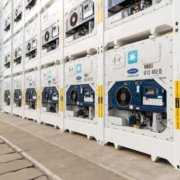Healthy habits create new traffic for temperature-controlled logistics
The growth in healthy eating habits has led to an increase in demand for temperature-controlled logistics
Lockdowns, and the subsequent re-openings of our societies have influenced how we, as a society, approach our overall health (we’re looking at you Peleton!). This demand for healthy nutrition, which is marked by the changing global diet trends, has increased. In response to that, cold logistics has become central in the response to meet this rising demand for fresh and frozen foods.
Many of the players in the reefer industry have noted that the growing healthy consumption habits have helped sustain growth in reefer volumes post-pandemic; a growth that is expected to continue despite the nuances of a more subdued 2022. “There is a growth in demand over the last few years, and there is an increasing need in the logistics sector to move products related to that trend, whether it is health products, fresh food or frozen food,” says Cold Chain Federation UK chief executive Shane Brennan (El Mercantil, October 2022), adding that “it is clear that this will be an area of safe investment for the next five to ten years”.
A maritime growth
When looking at overall reefer trends, it is clear that the maritime leg has taken a large volume of investments in recent years. Up to 46% of global trade in perishable goods is transported by sea – and in many cases these require very specific temperatures throughout the different stages of transport (in transit, in port, or even during the last mile delivery).
Different goods also have different standards set by international organisations, and it is pivotal for transport operators to ensure that perishable goods are transported in conditions that don’t affect product quality (for a refresher on the Cold Chain, head to our blog to read up on the Introduction to the Cold Chain).
Because more and more people want access to fresh fruits and vegetables (in- our out-of-season), the reefer container business has been thriving. The El Mercantil article quotes Gregory Tuthill, the director of SeaCube (an innovative North American company specialising in the leasing of containers) as having attested to this trend. “In general terms, we can talk about a growth that is accelerating right now and that has to do mainly with products such as fresh fruit and vegetables”. This trend has “an effect on the demand for refrigerated containers.”
With more reefer containers, more storage space in ports is also needed. As an example, we can look at the Port of Barcelona. Hutchison Port’s managed BEST container terminal in the Catalan Capital has enhanced its reefer services in recent years. The terminal is now able to carry out semi-automated pre-trip inspection services for reefer containers. Repairs to any damages can also be carried out on site. “The Hong Kong-based operator is in a position to offer an integral and complete service for reefer containers, from connection and disconnection, to their monitoring, or the personalised attention to super reefers.” Similar investment in temperature controlled equipment management has been seen in other ports of Europe, and is expected to grow in the coming years.
6 keys to an effective temperature-controlled logistics
From maintaining stable temperatures and documentation requirements, to packaging and security considerations, we recommend you our spanish course in Temperature-Controlled Supply Chain Logistics in Barcelona.
For more ifnormation on temperature-controlled supply chain logistcis in spanish, download and jump on the guide:
Sources:








